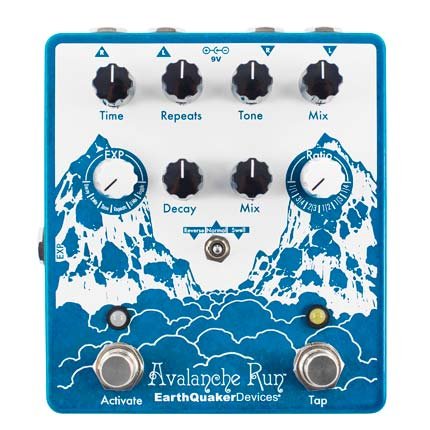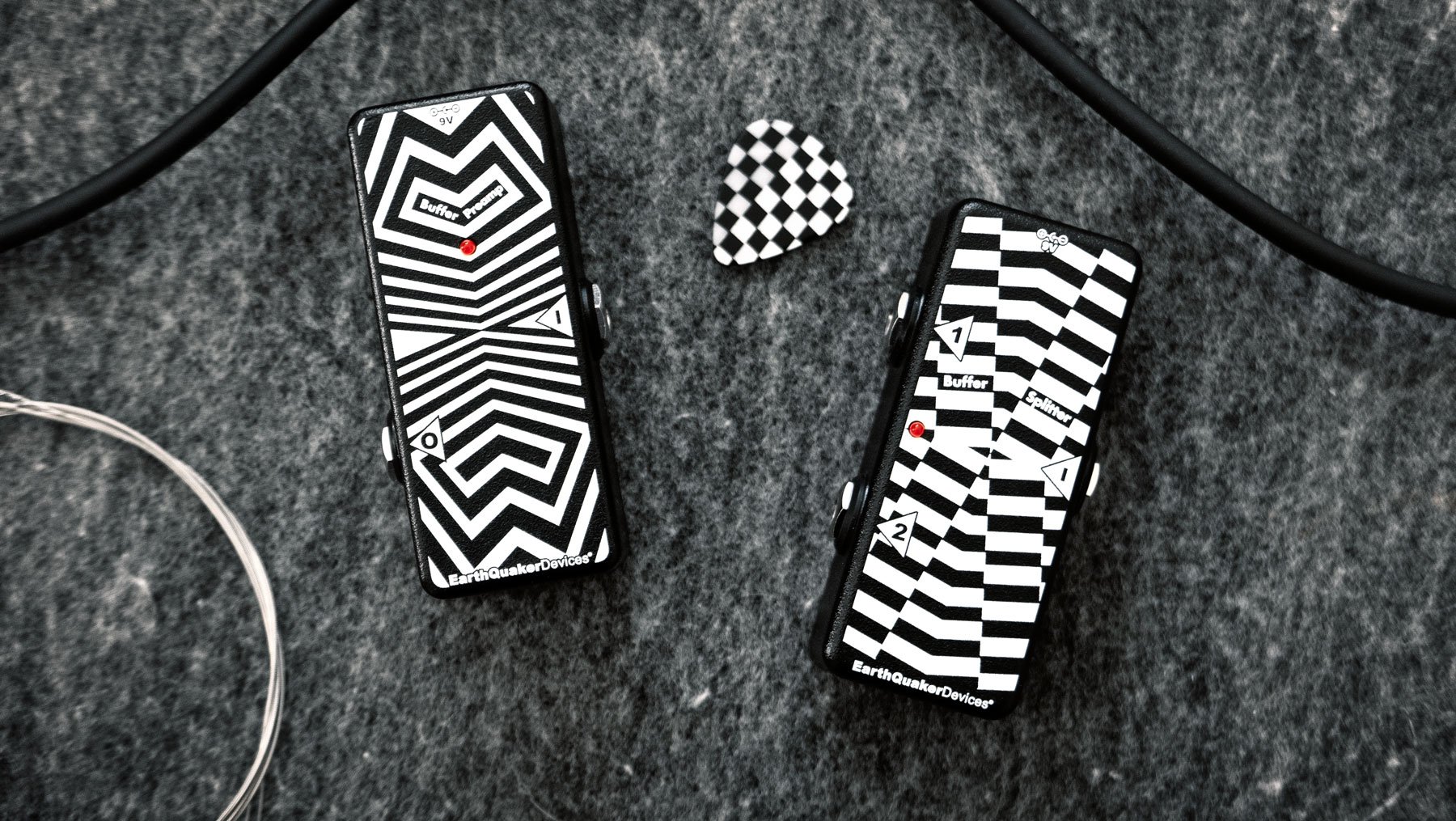Why the Avalanche Run is Still the GOAT
Dan Epstein
Originally introduced in 2016, and reissued two years later with updated stereo imaging, new Flexi-Switch® Technology and a half-inch wider enclosure, the Avalanche Run was designed to satisfy requests for a stereo and/or tap tempo-augmented version of EarthQuaker Devices’ Dispatch Master. Like its predecessor, the Avalanche Run offers a delicious combination of delay and reverb; but as it quickly becomes clear to anyone who plugs into it, the Avalanche Run has a sound and soul all its own.
Built using a high-powered proprietary DSP platform, the Avalanche Run contains a multitude of features and options within its remarkably user-friendly confines, creating sounds that range from dreamily ambient to aggressively hostile — and its sonic palette expands even further with the use of an expression pedal and the pedal’s stereo inputs and outputs.
Yes, the Avalanche run is one of the most expensive pedals in the entire EQD line, but it’s also one of the most mind-blowing — not to mention one of the most versatile. Guitars? Synths? Drums? Vocals? Brass and Wind instruments? The Avalanche Run can process them all in an incredible variety of ways… many of which you haven’t even imagined yet.
Why is the Avalanche Run V2 the greatest stereo delay and reverb stompbox of all time? And why is it such a marvelously useful creative tool, both onstage and in the studio? I could easily talk your ear off about its sheer awesomeness for hours — but since your time (and mine) would ultimately be better spent playin’ than yakkin’, let’s just touch on some of my favorite sounds that I’ve encountered in the pedal’s various modes while using the Avalanche Run with my guitar…
NORMAL MODE
As you might surmise from its name, the Avalanche Run’s Normal Mode delivers exactly the sort of effects you’d expect from a “standard” stereo reverb and delay pedal. And if I had to pick just one setting to show off just how beautifully the Avalanche Run’s reverb and delay complement each other, I’d put the Time, Repeats and Tone controls all at about noon or a little before, the top Mix knob — which controls the volume of the delay line — around 10 o’clock to give the dry signal more prominence, crank the Decay all the way up, and set the lower Mix knob (which controls the volume of the reverb) to around 1 o’clock. The resulting sound is hauntingly cavernous yet impressively precise, lending clean, fingerpicked guitar figures some really nice articulation, while also bathing them in gorgeous ambience.
However, if you want to go off into much trippier territory using Normal Mode, simply turn the top controls all the way down and crank the Decay and lower Mix controls all the way up — then pick out a few well-chosen notes. You’ll find yourself floating away on cascading clouds of reverbed drones in no time flat.
Of course, when some people think of “delay,” they immediately think of the skittery guitar figures of ‘80s-era U2, which the Avalanche Run can deliver as well. Just set the Time control to about 9 o’clock, the Repeats knob to about noon, and the Decay to around 2 o’clock; set the tempo to quarter notes using the Tap footswitch, turn the Ratio selector to ¾ (dotted eighths), and you’ll be ready to rock where the streets have no name!
And if you’re using an Expression pedal, setting the EXP switch to “Time” will enable you to achieve some pretty crazy pitch shifting effects, especially with the Decay and both Mix controls up past noon. Want to conjure up a flock of screaming, dive-bombing seagulls with your guitar, or generally freak out your neighbors? This’ll definitely do it.
REVERSE MODE
Ever since I first learned what was making those unearthly-yet-alluring wooshes on The Beatles’ Revolver LP, I’ve been obsessed with backwards sounds and signals, so it’s a given that I’d be a total sucker for the Avalanche Run’s Reverse Mode.
One of my favorite things to do in Reverse Mode is to play call-and-response psychedelic duets with myself. By turning the Time control all the way up and keeping the Repeats control all the way down, I can play a burst of notes up to two seconds long, which the Avalanche Run then answers with a backwards phrase so sweetly psychedelic that I start to wonder if there’s actually a tiny guitarist “tripping balls” somewhere inside the box. I use the Tone knob to control how brightly the reversed “answer” cuts through, and the Mix control on the top to adjust the blend of forward playing and reversed response to taste. Like many of the Avalanche Run’s effects, this one sounds especially cool and dramatic when you’re running the pedal in stereo out into two different amplifiers that are spaced at least a few feet apart.
Want an especially weird and attention-grabbing sound? When you turn the Time and Repeats knobs all the way down, and dial the Decay and both Mix controls to noon or beyond, Reverse Mode creates a glitchy, abrasive, ring modulation-type distortion whose dissonant, semi-random overtones that really work their magic when you’re playing single-note runs. If you’ve ever dreamed of making your guitar sound like a robot who’s mad as hell and ready to push the “Self-Destruct” button, this setting will definitely make your dreams come true!
And if you want to teleport yourself from the dystopian future back to the gloriously greasy 1950s, keep the above settings the same while turning the Time knob to somewhere between 8 and 9 o’clock. The glitchiness suddenly cleans up, and the Reverse Mode produces a nicely pulsating tremolo-with-reverb effect — think the closing bars of Link Wray’s “Rumble” — that really sounds like a slap-back blast from the past when you turn down the Decay and brighten up the Tone.
When the Avalanche Run is in Reverse Mode, the delay subdivisions are always 1/1, regardless of where the Ratio switch is set. But don’t let that dissuade you from experimenting with the Tap switch or your expression pedal in this mode, however, because you can still create some really freaky rhythmic parts and patterns with them. Try holding the Tap switch down to temporarily send the delay back to Normal (forward) mode, then releasing it when you want to go back to Reverse mode. Or put the EXP switch in the Toggle position, which will enable you to go back and forth from Reverse to Normal by using your expression pedal. And while you’re using the expression pedal, you can also simultaneously employ the Tap switch to send the delay into self-oscillation, thereby unleashing all manner of sonic heaven or hell, depending on your settings and general disposition.
SWELL MODE
I’ve always loved the sound of volume swells achieved via volume pedals or the guitar’s volume knob — but lack of pedalboard space and general hand-foot coordination have made both of those options non-starters for me. Thanks to the Avalanche Run’s Swell Mode, however, it’s become pretty easy to work volume swells into my playing. My favorite setting in this mode involves putting the Time control around noon, the Repeats control around 9 o’clock, the Tone control around 11, the top Mix control all the way down, both the Decay and the lower Mix controls around 3. The result is a beautiful, violin-like tone that really sings as it swells — and you can also get a cool “cello” effect in this setting by fretting the lower strings while also rubbing them with the fingers of your picking hand.
TAILS MODE
As cool as the Avalanche Run’s many sonic flavors and options may be, sometimes your music or performance will require you to turn the pedal off — and when you do so, you might want the wet signal to fade out organically, rather than cut abruptly. Of course, the Avalanche Run has you covered there, as well; the Tails Mode allows you to, er, tailor your delay tails to a length that best fits whatever you’re playing. Engaging the Tails Mode (which requires the simple task of unplugging the power cable and setting the Ratio switch to the desired Tail length before you plug it back in), gives you the option of short, medium and long tails, as well as “Sound on Sound” infinite repeats — which allow you to solo over an ambient pad — and “User Defined” custom tails that are determined by where the Repeats control is set.
The “User Defined” option has been my favorite part of Tails Mode, ever since I discovered that turning the Repeats knob nearly all the way up in this setting (a.k.a. “3/4” on the Ratio switch) creates a kind of “tape loop” effect which gradually becomes ever more degraded as it repeats. Set the Tone control all the way up to make the loop lose a little more of the low end each time it repeats, or all the way down to make it lose a little more of the high end each time. For added trippiness, put the Avalanche Run’s toggle switch in Reverse Mode, which will alternately loop the signal backwards and forwards!
So there ya go — and believe me when I tell you that this is all really just the barest tip of the creative iceberg when it comes to the Avalanche Run V2. The more time you spend experimenting and generally messing around with it, the more cool sounds you’ll coax out of it, and the more crazy ideas you’ll wind up putting into action. Don’t be surprised if the Avalanche Run winds up broadening your musical horizons in all sorts of unexpected ways.
Dan Epstein is an author, editor, journalist and guitarist based in New York's Hudson Valley. He writes about his latest musical obsessions at Jagged Time Lapse, and songs from his latest musical project The Corinthian Columns can be found at corinthiancolumns.bandcamp.com






